
Playlists
 |
Playlist Playlists |
|
Gemme musicali dalla colonne sonore di film memorabili Musical gems from the soundtrack of memorable films |
|
| Nota: E' disponibile una
versione
pdf di questo Dossier. |
Note: A
pdf version
of this Dossier is available. |
|
Versione italiana English version |
|
| La nostra playlist inizia con la più celebre scena del film di Luchino Visconti, Il gattopardo, dal romanzo omonimo di Tomasi di Lampedusa: il valzer finale che Nino Rota, il celebre compositore (e il preferito da Fellini), ha riarrangiato a partire da un valzer inedito di Giuseppe Verdi. Il panorama socio-culturale della Sicilia, nel delicato momento di passaggio dai Borboni ai Savoia, è reso magnificamente dall'accurata ricostruzione storica di Visconti, che dipinge con precisione e passione una fase politica segnata, secondo il regista, e nonostante i sommovimenti politici e militari, da un sostanziale immobilismo (come viene detto nel film: "Se vogliamo che tutto rimanga com'è, bisogna che tutto cambi"). Il film vinse la Palma d'Oro al Festival di Cannes del 1963. |
 Il gattopardo/The leopard (di/by Luchino Visconti, Italia/Italy-Francia/France 1963) |
Our playlist begins with the most famous scene from Luchino Visconti's film, The Leopard, from Tomasi di Lampedusa's novel of the same title: the final waltz that Nino Rota, the famous composer (and the favourite by Fellini), rearranged from an unpublished waltz by Giuseppe Verdi. The socio-cultural panorama of Sicily, at the moment of transition from the Bourbons to the Savoy dynasty, is magnificently recreated by Visconti's accurate historical reconstruction - with precision and passion, he stages a political phase marked, according to him, and despite political and military movements, by a substantial immobility (as the film says: "If we want everything to remain as it is, everything must change"). The film won the Golden Palm at the 1963 Cannes Film Festival. |
| La colonna sonora di Il laureato è famosa quanto il film, con le canzoni di Simon & Garfunkel che sono molto più di un semplice commento sonoro: accompagnano infatti tutte le principali sequenze del film, e contribuiscono a raccontare e commentare l'odissea di Benjamin (Dustin Hoffmann), fresco di college e alquanto incerto sul suo presente e sul suo futuro. In particolare, Scarborough Fair, ripresa da una tradizionale ballata medioevale inglese, sottolinea lo stato di confusione e sofferenza che Benjamin deve affrontare dopo che la sua relazione con la Signora Robinson è stata scoperta, e dopo che Elaine, la figlia della Robinson, lo ha lasciato. Benjamin si aggira spaesato e inquieto per il campus universitario, spia da lontano Elaine senza poterla avvicinare - ed è magistrale la scena in cui, seduto sul bordo di una fontana, un veloce zoom all'indietro ce lo mostra da solo con il background del campus, che rapidamente poi si riempie di studenti ... sottolineando ancor di più la sua solitudine. |
 Il laureato/The graduate (di/by Mike Nichols, USA 1967) |
The soundtrack of The graduate is as famous as the film, with Simon & Garfunkel's songs which are much more than a simple sound comment: they accompany all the main sequences of the film, and contribute to telling and commenting on the odyssey of Benjamin (Dustin Hoffmann), fresh from college and somewhat uncertain about his present and his future. In particular, Scarborough Fair, taken from a traditional English medieval ballad, underlines the state of confusion and suffering that Benjamin has to face after his relationship with Mrs. Robinson has been discovered, and after Elaine, Robinson's daughter, has left him. Benjamin wanders restlessly about the university campus, spies on Elaine from afar without being able to get closer to her, The masterful scene in which, sitting on the edge of a fountain, a quick backwards zoom shows him alone with the background of the campus quickly filling with students, emphasizes his loneliness. |
| Brani di musica classica sono spesso usati per le colonne sonore di film, ma in alcuni casi il loro uso si integra in modo particolare alle sequenze in cui sono inseriti. L'ouverture da Guglielmo Tell di Gioachino Rossini è stata ad esempio manipolata da Stanley Kubrick per realizzare una delle scene più originali e divertenti del suo Arancia meccanica. Il brano musicale è stato accelerato, così come il montaggio della sequenza a cui fa da sfondo, in modo da suggerire (più che realmente mostrare) l'orgia di sesso che il protagonista Alex (Malcolm McDowell) organizza con due ragazze incontrate per caso in un negozio di dischi (e che, all'ìinizio della sequenza, Alex apostrofa con "You are invited!" ("Siete invitate!"). Il risultato è tanto spassoso quanto illuminante nel deli9neare il carattere di Alex (che, ricordiamolo, per sua stessa ammissione ha come interessi vitali il sesso, la violenza e ... Beethoven ...). |
 Arancia meccanica/A clockwork orange (di/by Stanley Kubrick, USA 1971) |
Pieces of classical music are often used for film soundtracks, but in some cases their use integrates particularly well with the sequences in which they are inserted. For example, the Ouverture from William Tell by Gioachino Rossini was used by Stanley Kubrick to create one of the most original and entertaining scenes of A clockwork orange. The speed of the original musical piece was accelerated, as well as the editing of the sequence to which it acts as a background, in order to suggest (rather than really show) the sex orgy that the protagonist Alex (Malcolm McDowell) organizes with two girls he has just met by chance in a record shop (the girls Alex has picked up by sarcastically telling them, "You are invited!". The result is as amusing as it is illuminating in suggesting Alexc's character (whose vital interests, as the audience already knows, are sex, violence and ... Beethoven ...). |
| Bernard Herrmann, celebre compositore di musiche da film, ed il preferito da registi del calibro di Orson Welles e Alfred Hitchcock, scrisse la sua ultima colonna sonora per Taxi driver di Martin Scorsese. Nei titoli di testa lo sfondo musicale sottolinea con efficacia il tono e l'atmosfera generale del film, con un paesaggio urbano notturno, piovoso e fumoso, a suggerire la desolazione del panorama umano in cui si muove il protagonista, Travis Bickle (Robert De Niro). Di Travis, reduce dal Vietnam con pesanti traumi alle spalle, vediamo solo gli occhi, che non sembrano realmente "vedere" ma solo introiettare le sensazioni che, come tassista di notte, gli suggerisce la vita notturna di una New York mai più così sporca, desolata e violenta. Taxi driver riportò la Palma d'Oro a Cannes come miglior film. |
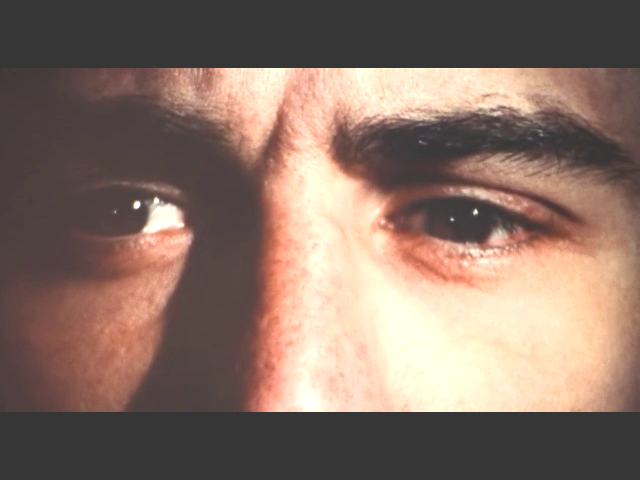 Taxi driver (di/by Martin Scorsese, USA 1976) |
Bernard Herrmann, a famous composer of film music, and the favourite by directors such as Orson Welles and Alfred Hitchcock, wrote his last soundtrack for Martin Scorsese's Taxi driver. In the opening titles the musical background effectively underlines the tone and general atmosphere of the film, with a rainy and smoky urban landscape, to suggest the desolation of the human panorama in which the protagonist, Travis Bickle (Robert De Niro) moves - just back from Vietnam with a heavy trauma behind him. We only see Travis's eyes, which do not really seem to "see" but only to intake the sensations that, as a taxi driver by night, are suggested by the nightlife of New York: a city that has never been seen so dirty, desolate and violent. Taxi driver won the Golden Palm for best film at the Cannes Film Festival. |
| Damien Chazelle è riuscito a realizzare nel 2016 un'impresa quasi impossibile: riportare in vita uno dei generi cinematografici più popolari e più rappresentativi del cinema americano: il musical. La La Land non è però una "copia" di musical passati quanto una reinterpretazione, con gli occhi di oggi ma con uno sguardo di nostalgia e di ammirazione per i capolavori passati di questo genere. La sequenza iniziale, tra le migliori del film e diventata quasi iconica, è una travolgente introduzione a una Los Angeles che rimane per tutto il film quasi una protagonista e ben più che uno sfondo. La coreografia di questa sequenza, basata sulla canzone "Another day of sun", fu girata come un unico lungo piano-sequenza su una vera autostrada di Los Angeles. Questo imponente sforzo produttivo fu coronato da numerosi premi, tra cui 6 Oscar e 7 Grammy Awards. |
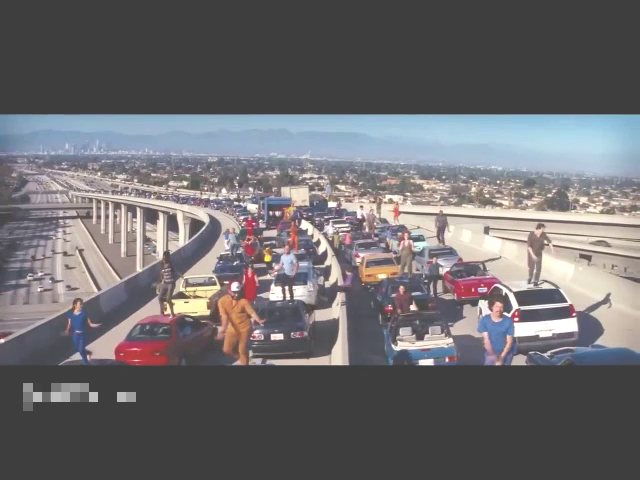 La La Land (di/by Damien Chazelle, USA 2016) |
Damien Chazelle managed to do something almost impossible in 2016: to bring back to life one of the most popular and most representative American cinema genres: the musical. La La Land is not so much a "copy" of past musicals as a reinterpretation, with today's eyes but with a taste of nostalgia and admiration for past masterpieces of this genre. The initial sequence, among the best in the film and which has become almost iconic, is an overwhelming introduction to Los Angeles, with the city becoming almost a protagonist, and much more than a background, for the whole film. The choreography of this sequence, based on the song "Another Day of Sun", was shot as a single longtake on a real Los Angeles freeway. This huge production effort was crowned by numerous prizes, including 6 Oscars and 7 Grammy Awards. |
| Il mito del West viene rivisitato invece in Butch Cassidy, che nel titolo italiano non menziona l'altro personaggio, il "Sundance Kid": insieme, Paul Newman e Robert Redford interpretano due simpatici e un po' ingenui fuorilegge, che, in un mondo ormai cambiato, si barcamenano (quasi) allegramente tra rapine varie fino al tragico epilogo. Lo spirito del '68 aleggia in tutto il film, dando corpo all'ansia di libertà e di anticonformismo che trasmettono i personaggi. Non è da meno la colonna sonora, firmata dal prestigioso compositore Burt Bacharach: in questa sequenza, che vede Newman esibirsi come uno stuntman in bicicletta, sotto gli occhi divertiti della ragazza che accompagna il duo (Katharine Ross), la musica si fonde perfettamente con l'azione, e la relativa canzone ("Raindrops keep fallin' on my head"), diventata rapidamente un successo mondiale, vinse l'Oscar per la miglior canzone. L'accoppiata vincente Newman-Redford tornerà, diretta dallo stesso regista, quattro anni dopo in un altro indimenticabile film, La stangata. |
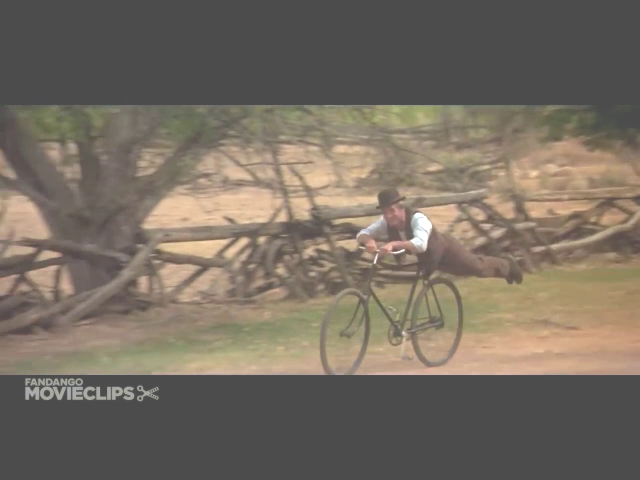 Butch Cassidy/Butch Cassidy and the Sundance Kid (di/by George Roy Hill, USA 1969) |
The myth of the West is revisited in Butch Cassidy and the Sundance Kid: Paul Newman and Robert Redford play two nice and a little naive outlaws, who, in a rapidly changing world, cheerfully go about various robberies until the tragic epilogue. The spirit of '68 hovers throughout the film, embodying the freedom and nonconformism that the characters convey. The soundtrack was signed by well-known composer Burt Bacharach. In this sequence, which sees Newman perform as a cycling stuntman, under the amused gaze of the girl (Katharine Ross) who accompanies the two outlaws, the music merges perfectly with the action. The song ("Raindrops keep fallin' on my head"), quickly became a worldwide success and won the Academy Award for best song. The winning couple Newman-Redford would return, with the same director, four years later in another unforgettable film, The sting. |
| Il terzo film della longeva, interminabile saga di James Bond (l'Agente 007 con licenza di uccidere), Missione Goldfinger, poteva già contare su uno strepitoso successo ottenuto, nel giro di soli due anni, dai primi due film. Caratteristica peculiare della saga, sin dal primo capitolo, è sempre stata la presenza di una canzone-simbolo nei titoli di testa, spesso elaboratissimi ed estremamente originali. "Goldfinger" diventò un grosso successo nell'interpretazione di Shirley Bassey, dando il via, nei successivi film, ad una serie di canzoni altrettanto famose, spesso interpretate da artisti di fama mondiale - da Tom Jones a Nancy Sinatra, da Paul McCartney a Carly Simon, dai Duran Duran a Tina Turner, da Madonna a Billie Eilish (la cui "No time to die" apre il film del 2020). |
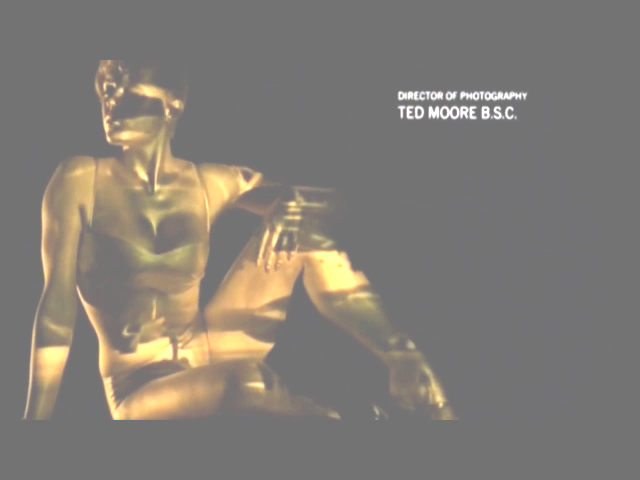 Agente 007 - Missione Goldfinger/Goldfinger (di/by Guy Hamilton, GB 1964) |
The third film in the never-ending saga of James Bond (the secret agent with a licence to kill), Goldfinger, could already count on the amazing success achieved, within only two years, by the first two films. A peculiar feature of the saga, from its very beginning, is the presence of an original song in the opening titles: "Goldfinger", sung by Shirley Bassey, immediately became a hit, opening the way, in subsequent films, to a series of equally famous songs, often sung by world-renowned artists - from Tom Jones to Nancy Sinatra, from Paul McCartney to Carly Simon, from Duran Duran to Tina Turner, from Madonna to Billie Eilish (whose "No Time to Die" we hear at the start of the 2020 film). |
| Un altro originalissimo utilizzo di un brano di musica classica accompagna l'ormai iconica sequenza del bombardamento aereo all'inizio di Apocalypse Now. La "Cavalcata delle Valchirie", dall'atto terzo dell'opera di Richard Wagner, qui eseguita dalla Vienna Philarmonic Orchestra, è stata sincronizzata con l'avanzare degli elicotteri, in un vertiginoso intreccio di musica ed esplosioni, che trasforma subito una scena di guerra, già di per sè potente, in una sofisticata quanto travolgente introduzione alla violenza tenebrosa del conflitto, che sarà una delle caratteristiche salienti di tutto il film. |
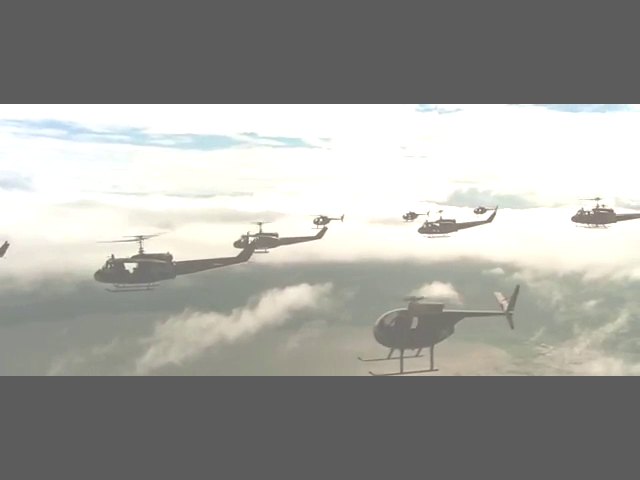 Apocalypse Now (di/by Francis Ford Coppola, USA 1979) |
Another very original use of a piece of classical music accompanies the iconic sequence of the air bombing at the beginning of Apocalypse Now. The "Ride of the Valkyries", from the third act of Richard Wagner's opera, performed here by the Vienna Philarmonic Orchestra, was synchronized with the advance of the helicopters, creating a dizzying intertwining of music and explosions. This powerful war scene is immediately transformed into a sophisticated and overwhelming introduction to the dark violence of the conflict, which will be one of the salient characteristics of the whole film. |
| Nel film musical/horror Last night in Soho, la colonna sonora torna ad essere uno dergli elementi portanti del film. Una ragazza un po' ingenua e tormentata nella psiche, Eloise "Ellie" Turner (Thomasin McKenzie), infatuata dalle atmosfere della "swinging London" degli anni '60, sogna di diventare una stilista di moda, ed una notte, durante un sogno, viene magicamente trasportata nel cuore di quella Londra tanto amata, che prende subito vita grazie ad alcuni grandi successi musicali dell'epoca. Entrata nel mitico Café de Paris, incontra una ragazza bionda, a lei molto somigliante ... è solo l'inizio di un incubo in cui Ellie vivrà sì quell'epoca tanto amata, ma dovrà anche superare una serie di esperienze terrificanti. Eppure molto del "cuore" di questo film vive grazie alla ripresa di tanti motivi famosi degli anni '60, che scandiscono come un originale contrappunto l'evolversi della storia. |
 Last night in Soho (di/by Edgar Wright, GB 2021) |
In the musical/horror Last Night in Soho, the soundtrack is conceived as one of the main elements of the film. Naive and tormented Eloise "Ellie" Turner (Thomasin McKenzie) is mad about the atmosphere of the 60s "Swinging London" and dreams of becoming a fashion designer. One night, during a dream, she is magically taken to the heart of that London, which immediately comes to life thanks to some great musical hits of the time. Entering the mythical Café de Paris, she meets a blonde girl, very much her like ... It is only the beginning of a nightmare in which Ellie will experience that so much loved era, but will also have to overcome a series of terrifying events. Yet much of the "heart" of this film lives thanks to several famous hits of the 60s, which mark the evolution of the story as it unfolds on the screen. |
| Nell'indimenticabile seconda parte della saga di Il Padrino, che rievoca la storia giovanile del patriarca mafioso don Vito e, insieme, l'ascesa e la fine in solitudine del figlio Mike (Al Pacino), c'è una sequenza particolare che vede la famiglia Corleone fare visita ai parenti in Sicilia. Dalla scena americana, che si fa sempre più tormentata ed angosciante, si passa ad un intervallo relativamente sereno, in cui i legami con la terra madre riaffiorano grazie al ritrovato rapporto con i parenti siciliani. La forza della tradizione si innesta dunque sulle vicende americane, e la colonna sonora di Nino Rota, premiata con l'Oscar, sottolinea l'impatto emotivo del ritorno alle origini. |
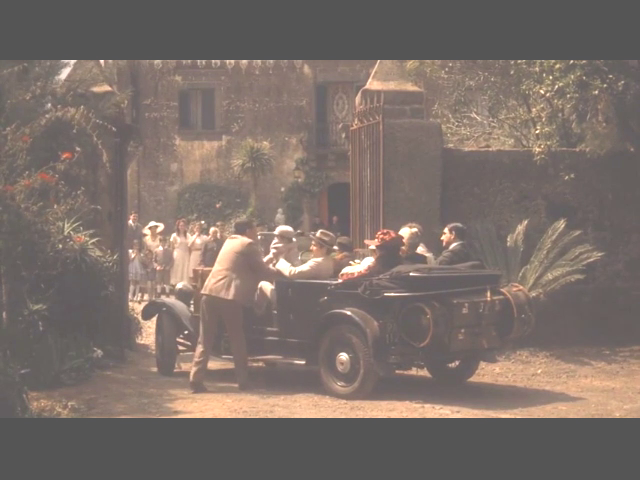 Il Padrino - Parte II/The Godfather, Part II (di/by Francis Ford Coppola, USA 1974) |
In the unforgettable second part of the Godfather saga, which recounts the youthful years of the mafia patriarch Don Vito as well as the rise and fall of his son Mike (Al Pacino), there is a particular sequence that sees the Corleone family visit relatives in Sicily. From the American scene, which becomes more and more tormented and distressing, we move on to a relatively serene interval, in which the ties with the motherland resurface thanks to the renewed relationship with the Sicilian relatives. The strength of tradition is therefore grafted onto the American events, and Nino Rota's soundtrack, which won an Academy Award, underlines the emotional impact of this "return to the origin". |